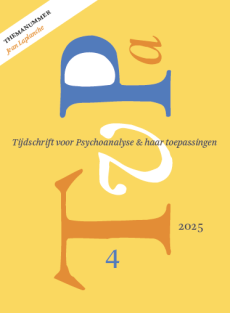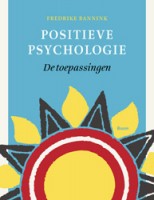Daedalus en Icarus: tussen labyrint en zon
Summary
Flying and mountain climbing can be seen as metaphors of the separation-individuation process as described by Mahler. Clinical material from a course of psychotherapy is shown as an illustration of this process.
Problem-solving as a creative act is seen as another way of separation-individuation. In the material it is made clear that there is a narcissistic value in the way this process takes place. A connection is made between creative anality and separation-individuation.
Literatuur
- Abraham, K. (1920), The narcissistic evolution of excretory processes in dreams and neurosis, uit: Selected papers of Karl Abraham. Hogarth Press, London (1948).
- Adler, G. (1989), Transitional Phenomena. Projective identification and the essential ambiguity of the psychoanalytic situation. Psychoanalytic Quarterly LVIII, p. 81-104.
- Baneke, J. (1996), Mythen van de tijd: over cultuur, tijd en psychoanalyse. In: A. Stufkens (red.), De psychische klok. Psychoanalytische opvattingen over tijd en tijdsbeleving, p. 88-111. Boom, Meppel.
- Bouvet, M. (1958), Technical Variations and the concept of distance. International Journal of Psycho-Analysis, 39, p. 211-221.
- Freud, S. (1905), Drie verhandelingen over de theorie der seksualiteit. Nederlandse Editie: Klinische Beschouwingen 1, p. 47. Boom, Amsterdam/Meppel (1985).
- Freud, S. (1914), Ter introductie van het narcisme. Nederlandse Editie: Psychoanalytische Theorie 1, p. 25. Boom, Amsterdam/Meppel (1985).
- Freud S. (1920), Aan gene zijde van het lust-principe. Nederlandse Editie: Psychoanalytische Theorie 1., p. 93. Boom, Amsterdam/Meppel (1985).
- Mahler, M.S., F. Pine & A. Bergman (1975), The psychological birth of the human infant. Hutchinson and Co., London.
- Mahler, M.S. (1979), The selected papers, Volume II: Separation – Individuation. Jason Aronson, New York/London.
- Matthijs, W. (1989), Weerzien met. Tijdschrift voor psychotherapie, 5, p. 324-334.
- Meijer, B.C. (1983), Notes on flying and dying. Psychoanalytic Quarterly, LII, p. 327-352.
- Pine, F. (1992), Some refinements of the separation – individuation concept in light of research on infants. Psychoanalytic Study of the Child, 47, p. 103-111.
- Shengold, L. (1988), Halo in the sky. Observations on anality and defense. The Guilford Press, New York.
- Stern, D.N. (1985), The interpersonal world of the infant. Basic Books, New York.
- Stolorow, R.D. (1975), Toward a functional definition of narcisism. International Journal of Psycho-Analysis, 56, p. 179.
- Winnicott, D.W. (1953), Transitional objects and transitional phenomena. International Journal of Psycho-Analysis, 34, p. 89-97.
- Wolff, E.C. (1982), Flying. Some psychoanalytic observations and consideration. Psychoanalytic Study of the Child, 37, p 461-483.
 © 2009-2025 Uitgeverij Boom Amsterdam
© 2009-2025 Uitgeverij Boom Amsterdam
ISSN 1382-516x
De artikelen uit de (online)tijdschriften van Uitgeverij Boom zijn auteursrechtelijk beschermd. U kunt er natuurlijk uit citeren (voorzien van een bronvermelding) maar voor reproductie in welke vorm dan ook moet toestemming aan de uitgever worden gevraagd:
Behoudens de in of krachtens de Auteurswet van 1912 gestelde uitzonderingen mag niets uit deze uitgave worden verveelvoudigd, opgeslagen in een geautomatiseerd gegevensbestand, of openbaar gemaakt, in enige vorm of op enige wijze, hetzij elektronisch, mechanisch door fotokopieën, opnamen of enig andere manier, zonder voorafgaande schriftelijke toestemming van de uitgever.
Voor zover het maken van kopieën uit deze uitgave is toegestaan op grond van artikelen 16h t/m 16m Auteurswet 1912 jo. Besluit van 27 november 2002, Stb 575, dient men de daarvoor wettelijk verschuldigde vergoeding te voldoen aan de Stichting Reprorecht te Hoofddorp (postbus 3060, 2130 KB, www.reprorecht.nl) of contact op te nemen met de uitgever voor het treffen van een rechtstreekse regeling in de zin van art. 16l, vijfde lid, Auteurswet 1912.
Voor het overnemen van gedeelte(n) uit deze uitgave in bloemlezingen, readers en andere compilatiewerken (artikel 16, Auteurswet 1912) kan men zich wenden tot de Stichting PRO (Stichting Publicatie- en Reproductierechten, postbus 3060, 2130 KB Hoofddorp, www.cedar.nl/pro).
No part of this book may be reproduced in any way whatsoever without the written permission of the publisher.
Nieuwsbrief Boom Psychologie
Meld u nu aan en ontvang maandelijks de Boom Psychologie nieuwsbrief met aantrekkelijke aanbiedingen en de nieuwe uitgaven.
Aanmelden


